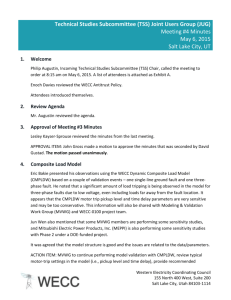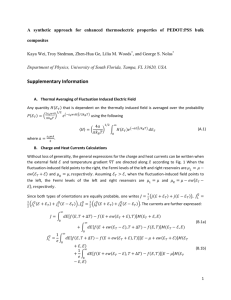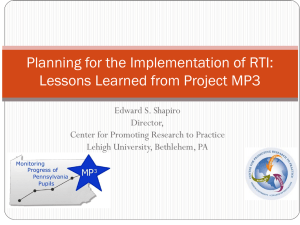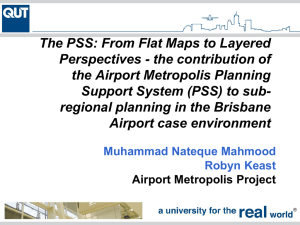WECC-0107 Posting 2 VAR-501-WECC
advertisement
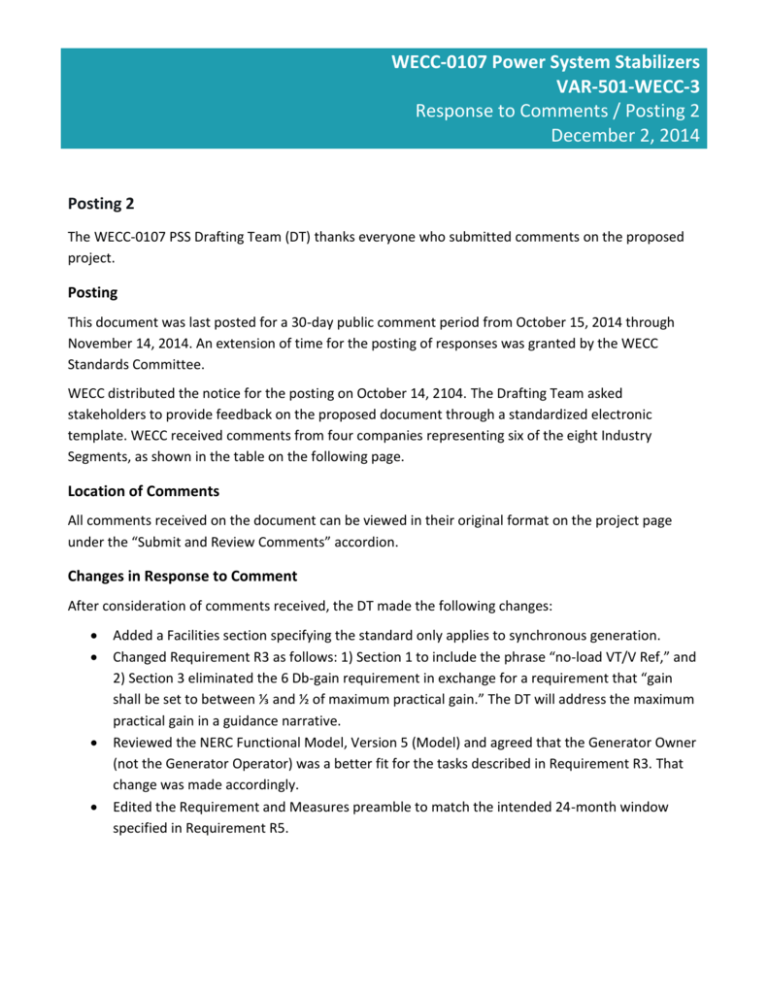
WECC-0107 Power System Stabilizers VAR-501-WECC-3 Response to Comments / Posting 2 December 2, 2014 Posting 2 The WECC-0107 PSS Drafting Team (DT) thanks everyone who submitted comments on the proposed project. Posting This document was last posted for a 30-day public comment period from October 15, 2014 through November 14, 2014. An extension of time for the posting of responses was granted by the WECC Standards Committee. WECC distributed the notice for the posting on October 14, 2104. The Drafting Team asked stakeholders to provide feedback on the proposed document through a standardized electronic template. WECC received comments from four companies representing six of the eight Industry Segments, as shown in the table on the following page. Location of Comments All comments received on the document can be viewed in their original format on the project page under the “Submit and Review Comments” accordion. Changes in Response to Comment After consideration of comments received, the DT made the following changes: Added a Facilities section specifying the standard only applies to synchronous generation. Changed Requirement R3 as follows: 1) Section 1 to include the phrase “no-load VT/V Ref,” and 2) Section 3 eliminated the 6 Db-gain requirement in exchange for a requirement that “gain shall be set to between ⅓ and ½ of maximum practical gain.” The DT will address the maximum practical gain in a guidance narrative. Reviewed the NERC Functional Model, Version 5 (Model) and agreed that the Generator Owner (not the Generator Operator) was a better fit for the tasks described in Requirement R3. That change was made accordingly. Edited the Requirement and Measures preamble to match the intended 24-month window specified in Requirement R5. Comment Report Form for WECC-0107 Power System Stabilizers Minority Comments Summary The DT reviewed and considered requests to include further clarification of the Requirements’ meaning. The DT agreed that it would provide additional narrative in a guidance section to explain the intent of the Requirements. Action Plan The DT will begin drafting the guidance narrative during the first week in December 2014. Once the proposed Requirements are vetted, the DT will revisit the format, Measures, and associated Compliance sections of the document. On December 3, 2014, the DT will request that the WECC Standards Committee post these responses. Contacts and Appeals If you feel your comment has been omitted or overlooked, please contact the W. Shannon Black, Manager, WECC Standards Processes, at sblack@wecc.biz. In addition, there is a WECC Reliability Standards Appeals Process. 1 1 The appeals process is described in the WECC Reliability Standards Development Procedures. 2 Comment Report Form for WECC-0107 Power System Stabilizers 3 The WECC Standards Voting Sectors are: 1 — Transmission Sector 2 — Generation Sector 3 — Marketers and Brokers Sector 4 — Distribution Sector 5 — System Coordination Sector 6 — End Use Representative Sector 7 — State and Provincial Representatives Sector 8 — Other Non-Registered WECC Members and Participating Stakeholders Sector Commenter Organization 42 Leonard Lima Kestrel Power 5 Cain Braveheart 6 Caitlin Liotiris Bonneville Power Administration Western Power Trading Forum (WPTF) 7 2 Karen Hedlund City of Tacoma WECC Standards Voting Sectors 1 2 3 4 5 6 7 X X X X X X X X X X X Comments 1, 2 and 3 were software testing and did not contain any substantive comments. 8 X Comment Report Form for WECC-0107 Power System Stabilizers Index to Questions, Comments, and Responses Question 1. The WECC-0107 Drafting Team welcomes comments on all aspects of this document. 4 Comment Report Form for WECC-0107 Power System Stabilizers 5 1. The WECC-0107 Drafting Team welcomes comments on all aspects of this document. Summary Consideration: See summary in the preamble of this document. Commenter Leonardo T. G. Lima, Kestrel Power Engineering Yes No Comment Requirements R1 and R2 Modern digital PSSs have thresholds, usually based on generator MW output, below which the PSS output is not added to the voltage regulator summation point (voltage error). The PSS function in the digital excitation controllers is in service and operating as expected (as commissioned), even though the PSS is not providing any additional damping. This feature is particularly relevant for hydro units with a "rough zone" associated with the turbine operation within certain MW levels. The PSS is usually commissioned to add damping for generator MW output above such "rough zone", as the PSS cannot operate effectively when the turbine is within the rough zone. Thus, it is very important to clarify that this is an operation as expected (something that needs to be described only once, as mentioned in Measure M1). Also, it is important to mention that the PSS is in service all the time (while the generator is synchronized) as required in R2. The PSS has not been "removed from service" just because its logic precludes the PSS from adding damping for generator MW output below this threshold. This issue, of the generator MW threshold above which the PSS is intended to add damping, is partially addressed in the "Guideline and Technical Basis" section of the document, but it needs to be an integral part of the Standard, either in the Requirements or in the Measures. Requirement R3 Comment 1 The PSS should compensate the phase characteristic of the generator and excitation system characteristic associated with the GEP(s) transfer function [4, 5], defined as the transfer function from voltage reference set point Vref to electrical torque Te, when the rotor angle of the machine is held constant. This transfer function cannot be measured in the field, since it is impossible to hold the rotor angle position constant for the duration of the frequency response test. In other words, GEP(s) can only be estimated based on simulation results. Comment Report Form for WECC-0107 Power System Stabilizers 6 Summary Consideration: See summary in the preamble of this document. Commenter Yes No Comment On the other hand, the phase characteristic of GEP(s) is identical to the phase characteristic of the transfer function from Vref to terminal voltage Et, if the effects of changes in rotor angle position can be eliminated or, at least, minimized. In the Heffron-Phillips diagram [4], this is equivalent to imposing a constant rotor angle position or making the gains K4 and K5 as close as possible to zero. Therefore, to bring the gains K4 and K5 as close as possible to zero, the frequency response test has to be performed with the generation unit synchronized to the grid at its lowest stable load (in theory, K4 and K5 are zero when the power output of the generator is zero). Thus, performing the frequency response test with the generator at near full load is incorrect, resulting in an incorrect measurement of the required phase compensation for the PSS. Also, the frequency response test at near full load caries the risk of a resonance, associated with the local mode of oscillation of the unit. This resonance effect also introduces an error into the magnitude and phase characteristics of the measurement, which are eliminated when the measurement is performed at no load. The Standard should clearly state that the compensated frequency response corresponds to the phase of GEP(s) (obtained via simulation) or the phase of the frequency response Et/Vref (field test) performed at the lowest stable MW load of the generation unit. Comment 2 The frequency range of interest should be modified to 0.2 Hz to 2.0 Hz. The frequency of inter-area electromechanical oscillation modes does not get as low as 0.1 Hz, ever, anywhere in the world (in any known interconnected system). The lowest inter-area oscillation frequency that I know has been recorded in an actual power system was in the Brazilian system (0.17 Hz), when the first tie-line interconnecting the North and the South of the country was energized. The frequency of this inter-area mode is presently well above 0.20 Hz, due to the completion of additional tie-lines that reinforced the North-South interconnection [1]. Comment Report Form for WECC-0107 Power System Stabilizers 7 Summary Consideration: See summary in the preamble of this document. Commenter Yes No Comment The requirement of ±30 degrees of phase compensation at the low frequency of 0.1 Hz results in three technical problems: a) The washout time constants have to be increased, to meet the ±30 degrees requirement, or an additional phase lag has to be introduced; b) once the PSS is commissioned to respond to such low frequencies as 0.1 Hz, it might respond to disturbances in the turbine (mechanical) system, which the PSS cannot affect or modify (add damping). In such events, the PSS would simply amplify and feedback these mechanical disturbances into the generator excitation system, affecting the voltage control and reactive power output of the unit; and c) The PSS will introduce excessive terminal voltage variations for system events which produce large or sustained off nominal frequency conditions Thus, requiring the appropriate phase compensation starting at 0.2 Hz (instead of 0.1 Hz) would automatically result in the use of lower values for the PSS washout time constants, with all the benefits associated with it. On the other hand, since there are no inter-area oscillation frequencies as low as 0.1 Hz, the effectiveness of the PSSs in providing damping to the actual inter-area oscillations in the WECC system would not be compromised. Although the focus of this WECC Standard is on system (inter-area) oscillation modes, the PSSs need to provide damping to the local mode of oscillation of the unit. And, typically, these local modes have frequencies higher than 1.0 Hz. Thus, the PSS needs to provide the appropriate phase compensation for frequencies higher than 1.0 Hz. Thus, either the Standard reflects a change in the frequency range of interest (as suggested, from 0.2 Hz to 2.0 Hz) or at least it should mention that proper phase compensation is required for frequencies above 1.0 Hz for proper operation of the PSS regarding the local mode of oscillation. Comment 3 WECC should also clarify what is the proper interpretation of "gain margin of 6 dB.” A gain margin calculation implies the definition of a maximum gain, and this maximum gain has to be clearly defined. Comment Report Form for WECC-0107 Power System Stabilizers 8 Summary Consideration: See summary in the preamble of this document. Commenter Yes No Comment The theoretical definition of gain margin is the ratio between the actual gain of the control system (in this case, the nominal PSS gain) and the maximum gain that could be used in this control system, the threshold to instability. A gain margin of 6 dB means that the nominal PSS gain should be approximately ½ of the maximum gain. In practice, noise can become a limiting factor, way before reaching the threshold of any instability (either the "theoretical" stability limit, as determined via simulation, or a "practical" stability limit, as determined via field tests during commissioning) [2]. The difficulties associated with noise become more noticeable as the phase lead requirement of the PSS increases, since increasing the phase lead compensation results in an increase in the highfrequency gain of the PSS. Kestrel has found that, in practice, the high-frequency gain of the PSS should not exceed 500 pu. The phase lead requirement and thus the PSS high frequency gain are related to the exciter and generator characteristics, as long recognized by WECC in its "Criteria to Determine System Suitability for PSS" [3]. This version of the proposed Standard does not mention the suitability criteria for PSS application [3] and thus requires a PSS to be commissioned even on machines that, under that suitability criteria, would not be recommended to have a PSS installed. When a PSS is required to provide more phase compensation (to meet the ±30 degrees requirement), this will directly increase the high frequency gain of the PSS and will increase the likelihood of noise becoming a limiting factor to the PSS gain. Further increasing the PSS gain would only increase the amplification of noise at the PSS output (and injected into the excitation system), so no additional improvement in damping can be obtained. In some cases, the final PSS gain will be much lower than ½ of the theoretical maximum gain leading to instability, as observed in simulations, as simulations do not represent noise or very small time constants and delays which are present in real hardware and software PSS and voltage regulators. Comment Report Form for WECC-0107 Power System Stabilizers 9 Summary Consideration: See summary in the preamble of this document. Commenter Yes No Comment Thus, we suggest a text like "PSS gain shall be set to provide a gain margin of at least 6 dB with respect to the maximum PSS gain that could be achieved during field testing or commissioning.” Usually, the records of the field tests with the maximum PSS gain and the nominal PSS gain are part of any PSS commissioning, so these records could be added to the list in Measure M3. References [1] I. Kamwa, R. Grondin and G. Trudel, “IEEE PSS2B versus PSS4B: The Limits of Performance of Modern Power System Stabilizers”, IEEE Trans. on Power Systems, vol. 20, no 2, May 2005, pp. 903-915 [2] H. Vu and J. C. Agee, “Comparison of Power System Stabilizers for Damping Local Mode Oscillations”, IEEE Trans. on Energy Conversion, vol. 8, no. 3, September 1993, pp. 533-538 [3] WECC Guideline, “Criteria to Determine Excitation System Suitability for PSS in WECC”, January 1993. [4] F. P. de Mello and C. Concordia, “Concepts of Synchronous Machine Stability as Affected by Excitation Control”, IEEE Trans. on Power Apparatus and Systems, vol. 88, no. 4, April 1969, pp. 316329 [5] E. V. Larsen and D. A. Swann, “Applying Power System Stabilizers – Part I: General Concepts”, IEEE Trans. on Power Apparatus and Systems, vol. 100, no. 6, June 1981, pp. 3017-3024 Comment Report Form for WECC-0107 Power System Stabilizers 10 Summary Consideration: See summary in the preamble of this document. Commenter Yes No Comment Mr. Leo Lima of Kestrel joined the DT meeting and engaged the DT in discussion of Kestrel’s comments and concerns. Mr. Kestrel graciously accepted an invitation to engage in the drafting process. In response to Kestrel’s comments, no changes were made to Requirements R1 or R2. The DT made a change in Requirement R3, Section 1 to include the phrase “no-load VT/V Ref.” It also changed Requirement R3, Section 3 eliminating the 6 Db gain requirement in exchange for a requirement that “gain shall be set to between ⅓ and ½ of maximum practical gain.” The DT will address the maximum practical gain in a guidance narrative. The resulting Requirement now reads: R3. Each Generator Owner shall tune its PSS to meet the following inter-area-mode criteria: [Violation Risk Factor: Medium] [Time Horizon: Operating Assessment] 1) PSS shall be set to provide a compensated no-load VT/V Ref frequency response of the excitation system and synchronous machine such that through the frequency range from 0.1 Hertz to 1.0 Hertz, the phase will not exceed ±30 degrees. 2) PSS output limits shall be set to provide at least ±5 percent of the synchronous machine’s nominal terminal voltage. 3) PSS gain shall be set to between ⅓ and ½ of maximum practical gain. 4) PSS washout time constant shall be no greater than 30 seconds. The DT noted Kestrel’s request for additional guidance and clarification of the Requirements. Rather than incorporate the clarifying narrative into the Requirements, the DT concluded that adding a rationale box or guidance section in support of the Requirements would be of greater value. The DT agreed to begin drafting that narrative during the first week in December 2014. Mr. Lima agreed to participate in drafting the narrative. Kestrel raised concerns that, if accepted, the standard could be in conflict with existing WECC Guidelines that are under the auspice of the WECC Standing Committees, such as the WECC Operating Committee. The DT agreed with Kestrel’s concern; however, making changes to guidelines is outside of the scope of this Standards Authorization Request. The DT agreed to communicate Kestrel’s concerns to the appropriate Standing Committee. Kestrel requested a change from .1 Hz to .2 Hz in Requirement R3. The DT agreed the request had merit but concluded that additional technical support/research would be needed to change the .1 reference as .1 has been the WECC threshold for decades. The DT agreed to consult WECC staff and the Joint Synchronized Information Subcommittee to determine if there was any historic or substantive basis for the .1 reference. Cain Braveheart, Bonneville Power Administration The Bonneville Power Administration appreciates the opportunity to provide feedback regarding WECC-0107 PSS Design and Performance but does not have any comments at this time. Thank you. The drafting team thanks Bonneville Power for its continued support and participation in the standards development process. Comment Report Form for WECC-0107 Power System Stabilizers 11 Summary Consideration: See summary in the preamble of this document. Commenter Caitlin Liotiris Western Power Trading Forum Yes No Comment WPTF supports the latest round of modifications the Drafting Team has made to the proposed standard. Generally, the latest changes represent a significant improvement. Specifically, WPTF appreciates the modifications to R1 and R2 which require notification of the operating specifications for the PSS and provide circumstances under which PSS may be out of service. Taken together, these two requirements should ensure GOPs keep PSSs in operation as often as is possible, thus promoting reliability in the interconnection. Further, WTPF appreciates the modifications to R4, which provide much greater clarity on when PSS installation is required on existing units. Finally, the addition of R5, which requires PSS repair or replacement within a specified time, should also enhance reliability. WPTF believes there is one substantial oversight in the current version of the standard, relating to the applicability of the requirements. The current requirements for PSS operation contained in VAR-501-WECC-1 only apply to synchronous generators. However, the latest version of the standard posted for comment does not specify that the requirements are only applicable to synchronous generators. The Drafting Team should modify the language in the proposed standard to clarify that the PSS requirements are only applicable to synchronous generators. If the Drafting Team intended to expand the PSS requirements to asynchronous generators, that should be made clear in the preamble to the standard and justification for such an expansion should be provided. WPTF appreciates the opportunity to submit comments and looks forward to continue working with the Drafting Team on this project. The drafting team added the following “Facilities” section. 5. Facilities: This standard only applies to synchronous generators.” Comment Report Form for WECC-0107 Power System Stabilizers 12 Summary Consideration: See summary in the preamble of this document. Commenter Karen Hedlund Tacoma Power Yes No Comment General Comment – The current WECC Policy Statement on Power System Stabilizers clearly states the requirement of PSS installation on existing generators with the statement "A PSS shall be installed on every existing synchronous generator that is larger than 75 MVA and is equipped with a suitable excitation system.” On page 8, requirements and measures line 6 states "Requirement R4 would mandate installation of PSS on BES units, but only after a set of specified triggering events.” However, requirements on when existing BES generators that are not equipped with a PSS will require a PSS is not clearly stated within the proposed standard itself. R4 requires a PSS to be installed on newly-connected generators to the BES, and when the voltage regulators are replaced on existing excitation systems. Tacoma's interpretation of the standard is that PSS systems are not required to be added to existing generators until such time as the voltage regulator is replaced (R4). If this is not the intention of the DT then further clarification should be made within the requirements of the standard. R1 – No Comment R2 – No Comment R3 – This Requirement requires a Generator Operator to tune its PSS to certain specifications. It is the role of the Generator Owner to replace and maintain the generating units including the voltage regulator and therefore it is the Generator Owner's responsibility to replace and tune the excitation systems. It is not clear how the Generator Operator entity would "tune its PSS" since it does not own the PSS but rather simply operates the PSS in order to supply energy to the grid. It is recommended to change the entity ownership of this requirement to Generator Owner. R4 – No Comment R5 1. On page 8 "Requirements and Measures" under Requirement 5 the replacement timeframe of 6 months conflicts with the timeframe of 24 months stated in R5 of the proposed standard. Comment Report Form for WECC-0107 Power System Stabilizers 13 Summary Consideration: See summary in the preamble of this document. Commenter Yes No Comment 2. Under what conditions does the term "non-operational" apply? A PSS component failure may cause the PSS to be non-operational and therefore it requires replacement under this Requirement. But consider an unusual transmission line condition where the PSS disrupts system stability and the PSS is placed in an extended non-operational or off-line mode. Is compliance achieved for this requirement by having documented evidence as described in M2 item 3 for such an event? General Comments The drafting team concurs with your understanding of the standard based on your comments as provided in the General Comment segment of your responses. Requirement R3 The drafting team reviewed the NERC Functional Model, Version 5 (Model) and agreed that the generator Owner was a better fit for the task than the Generator Operator. That change was made accordingly. Within the Model, tasks assigned to the generator Owner include: 1) establishing generating facilities ratings, limits, and operating requirements; 2) designing and authorizing maintenance of generation plant protective relaying; 3) being responsible for systems, protective relaying systems on the transmission lines connecting the generation plant to the transmission system, and Special Protection Systems; 4) maintaining owned-generating facilities; and 5) providing verified generating-facility performance characteristics and data. Requirement 5 The DT retained the 24-month window in Requirement R5. The Requirements and Measure preamble was altered to match. If the Transmission Operator instructs that the PSS be taken off-line, such an instruction does not constitute “non-operation.” The intent of the Requirement was to address those circumstances with the PSS is broken and cannot function as intended.


